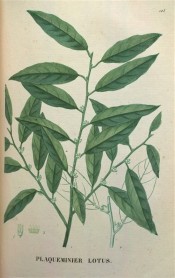Diospyros lotus L.
Fully hardy, spreading deciduous tree with lance-shaped leaves, to 12cm long, and tiny, bell-shaped, red-tinged green flowers in summer, followed by inedible, spherical to ovoid, yellow to purple fruit, to 2cm across, on female plants. To 10m. [RHSE, Hortus, Hilliers’].
Horticultural & Botanical History
Cultivated in Europe since c.1596. The fruit was in the past recommended as a cure for diarrhoea. [Don]. Diospyros lotus is not a native of Europe but was probably introduced to Britain from Italy, hence the common name used by Macarthur. ‘The European lotus, or Date Plum, is rather tender in Britain, but ripens its fruit in the south of France. The Virginian Diospyros, of which Loudon says all the other American sorts are only varieties, is not unlike the European Lotus; it thrives best in damp peat, and is often much injured by frost. In India many species are found, where they are remarkable for the hardness of the wood.’ [JD]. Saint-Hilaire Tr. pl.125/1825.
History at Camden Park
First mentioned in the 1843 catalogue and also listed in 1845 and 1850, but obtained again from Kew Gardens, brought out from England by Captain P. P. King in 1849. Macarthur indicated that it was not new to the colony. [ML A1980-3]. A Diospyros sp. still grows in the gardens.
Notes
- Diospyros lotus Blanco (1837) = Diospyros multiflora Blanco
- Diospyros lotus Lour. (1790) = Diospyros loureiriana G.Don
Published Mar 12, 2009 - 05:19 PM | Last updated Jul 17, 2010 - 04:56 PM
| Family | Ebenaceae |
|---|---|
| Category | |
| Region of origin | South west Asia to China |
| Synonyms | |
| Common Name | Date plum |
| Name in the Camden Park Record | Diospyrus lotus - European Date-plum |
| Confidence level | high |


